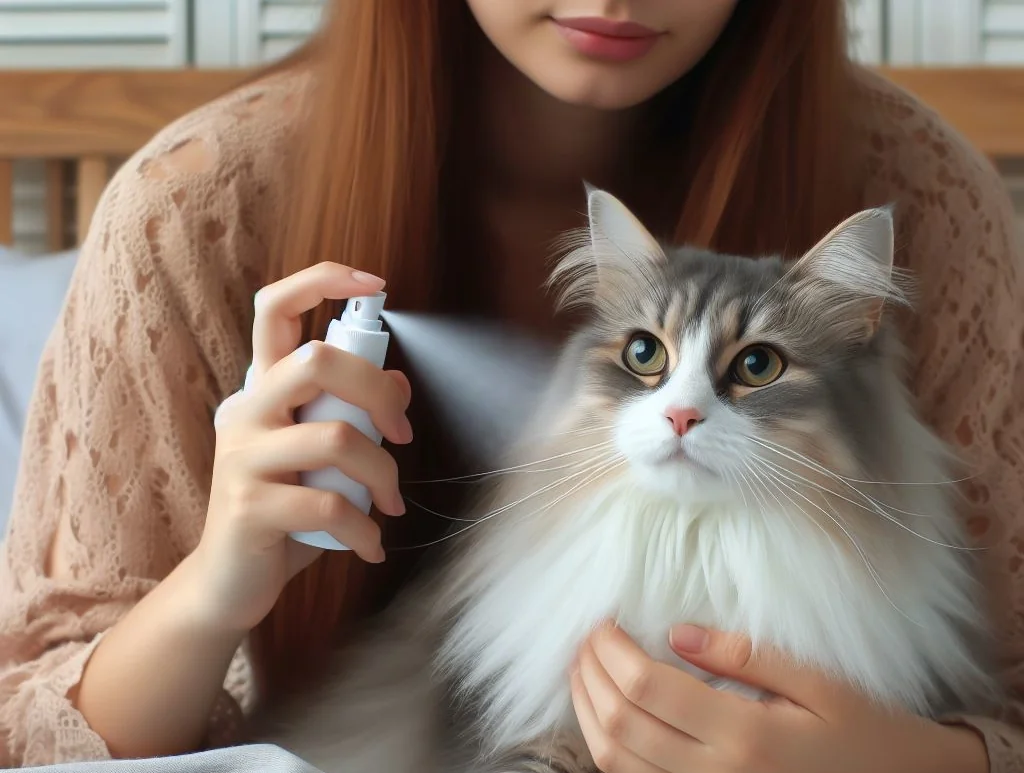Cats: adorable, fluffy bundles of joy that have the uncanny ability to send some people into a sneezing frenzy. Whether you’re the proud owner of a kitty or you’re just trying to visit a friend without needing a box of tissues and an inhaler, managing allergies can be a hairy situation.
This blog post is your go-to guide for keeping allergies at bay so that you and your beloved felines can live in harmony.

Quick Takeaways:
- Regular grooming and use of HEPA filter vacuums significantly reduce cat allergens in your home.
- Antihistamines before visiting and maintaining “cat-free” zones can minimize allergy symptoms.
- Investing in air purifiers and considering hypoallergenic cleaning products are key for an allergen-reduced living space.
What Can You Do to Reduce Cat Allergens at Home?
Living with cats doesn’t have to mean living with sneezes and sniffles if you or someone in your home is allergic. You’ll find that a few regular habits can make a big difference in keeping those allergens at bay.
-
Regular Grooming : It sounds straightforward, but you’d be surprised how much of a difference regular brushing can make. By grooming your cat outside (or in a well-ventilated area), you’re preventing loose hair and dander from finding their way into every corner of your home. Consider using grooming tools like the FURminator, which is designed to reduce shedding effectively.
-
Air Purifiers : Invest in a quality HEPA air purifier. These devices can capture particulate matter down to 0.3 microns, including cat dander. Placing one in the main living area and another in the bedroom can significantly reduce allergen levels. The Honeywell True HEPA Allergen Remover is a solid choice that covers large areas well.
-
Vacuuming and Dusting : Frequent vacuuming and dusting can remove allergens that settle on surfaces and in carpets. Using a vacuum equipped with a HEPA filter is key, as it ensures allergens are trapped instead of being spewed back into the room. Don’t forget to clean areas where cat hair tends to accumulate, such as under furniture and on window sills.
An often overlooked but unique tip is to create an “allergen-reduced” zone, preferably the allergic person’s bedroom. Make this space off-limits to your feline friend and use allergen-proof mattress and pillow covers to further reduce exposure during sleep, when prolonged exposure to allergens can worsen symptoms.
How Can Visitors Prepare Themselves Before Visiting a Home with Cats?
If you’re allergic to cats but your friend’s new kitten is too cute to resist, don’t worry, there’s hope. With a little preparation, you can enjoy your visit without the need for a box of tissues.
-
Pre-Visit Antihistamines : Taking an antihistamine about an hour before your visit can help preempt allergic reactions. Over-the-counter options like cetirizine (Zyrtec) or loratadine (Claritin) are effective for many people.
-
Protective Clothing : Wearing long sleeves and pants can protect your skin from direct contact with allergens. Also, consider bringing a change of clothes for after the visit to avoid bringing allergens back to your own home.
-
Communicate with Your Host : Don’t be shy about asking your host if they can keep the cat in a separate room during your visit. Most cat owners understand and will be accommodating. Additionally, you can inquire if they’d be willing to use an air purifier in the room where you’ll be spending time.
Remember, each person’s allergies are unique, so what works for one might not work for another. Experimenting with these strategies and finding what best suits you is key.

Are There Hypoallergenic Cats?
The quest for a truly hypoallergenic cat continues, but the truth is, no cat breed is 100% allergen-free. However, certain breeds are known to produce fewer allergens, making them more suitable for allergy sufferers.
Breeds like the Sphynx, Russian Blue, Siberian, and Balinese produce less of the protein Fel d 1, the main allergen present in cat saliva and dander. While these breeds may be easier on allergies, individual reactions can vary widely.
It’s crucial to spend time with a cat before adopting, to see how your allergies react. Visiting a shelter or a breeder and spending time with your potential pet can provide valuable insight into how well you’ll cope.
Moreover, keep in mind that regular grooming and cleaning are still necessary even with these breeds to minimize allergens. An interesting piece of advice for potential pet owners is to use pet wipes on their cat. Specifically formulated pet wipes can help remove saliva and dander directly from your cat’s coat, further reducing allergen levels.
In conclusion, managing allergies while owning or visiting a home with cats is entirely possible through a combination of preparation, communication, and understanding. Whether you’re a cat owner looking to reduce allergens at home or a visitor trying to navigate a visit, the right strategies can lead to more comfortable and enjoyable interactions with these beloved pets.
What Are the Best Ways to Clean Your Home If You Own a Cat?
Keeping your home clean and free from allergens when you have a furry friend around might seem like a Herculean task. But, fear not! With the right tools and tricks up your sleeve, it’s perfectly manageable. Let’s get down to brass tacks.
First off, not all vacuums are created equal, especially when it comes to picking up cat hair and dander. Opt for a vacuum with a HEPA (High Efficiency Particulate Air) filter. These wonders can trap particles as small as 0.3 microns – goodbye, sneaky allergens! Brands like Dyson and Shark have some great options that won’t just push the allergens around but actually lock them away.
Next, let’s talk cleaning products. The buzzword here is “hypoallergenic.” These products will be your best friend because they’re less likely to cause an allergic reaction. From sprays to wipes, choosing these allergy-friendly options ensure that you’re not just replacing one allergen with another.
Lastly, an air filtration system is not just icing on the cake; it might just be the whole cake when living with a cat. A good air purifier with a HEPA filter can significantly reduce the amount of airborne dander. It’s like having a silent, 24/7 cleaner removing allergens from your home air.
Unique Tip: Don’t overlook the power of a good steam cleaner for your furniture and carpets. Heat kills many allergens, making this an excellent tool for deep cleaning, especially in areas your cat loves to frequent.
Can Diet and Health Changes in Cats Reduce Allergens?
You might be surprised to learn that what your cat eats and how healthy they are can significantly impact the allergens they produce. It’s all connected!
First, a top-notch diet can do wonders. Cats fed a balanced diet rich in omega-3 fatty acids might have healthier skin, which means less dander. Consider incorporating foods or supplements containing fish oil or flaxseed oil for a glossy coat and reduced shedding.
Regular vet check-ups aren’t just for vaccinations; they’re also a crucial step in keeping those allergens at bay. Conditions like flea allergies, skin infections, or obesity can lead to increased shedding and dander production. Keeping your cat in tip-top shape can make a big difference.
Here’s the kicker, though: some studies suggest that certain probiotics might help reduce the allergens cats produce. While more research is needed, it’s an intriguing possibility that adding a probiotic supplement to your cat’s diet could be beneficial for you and your pet.
Example: The Journal of Allergy and Clinical Immunology published a study indicating a promising reduction in the major cat allergen, Fel d 1, through dietary supplementation with specific probiotics.
Lifestyle Adjustments for Living with Cats and Allergies
Living harmoniously with your cat means making some tweaks to your lifestyle, but it’s all about finding the right balance.
Creating “cat-free” zones, especially in the bedroom, can provide an allergen-reduced sanctuary for you to breathe easy and get a good night’s rest. It might take some training (and a bit of heartache), but it’s worth it for your health.
Consider having specific clothes to wear at home. These “cat clothes” can be easily changed out of before leaving the house or settling into your clean zone, helping to minimize the spread of allergens.
Lastly, investing in a personal air purifier for your workspace or bedside can bring additional relief, creating a mini oasis free from allergens. Though it might seem like a small step, it can significantly impact your overall comfort and well-being.
Remember, managing allergies doesn’t mean you can’t enjoy the love and companionship of your feline friend. With these strategies, both you and your cat can live together happily and healthily.
Alex, a passionate animal lover, has experience in training and understanding animal behavior. As a proud pet parent to two dogs and three cats, he founded AnimalReport.net to share insights from animal experts and expand his knowledge of the animal kingdom.




